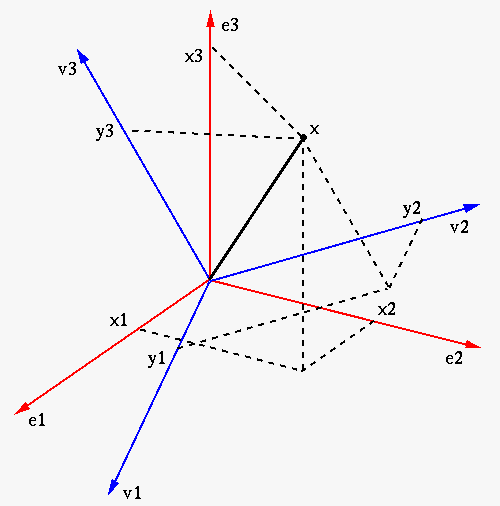Next: Optimality of KLT Up: Principal Component Analysis Previous: Covariance and Correlation
A data point in a d-dimensional space is represented by a vector
![${\bf x}=[x_1,\cdots,x_d]^T$](img2.svg)


 |
 |
![$\displaystyle \left[\begin{array}{c}x_1\\ x_2\\ \vdots\\ x_d\end{array}\right]
...
...begin{array}{c}0\\ \vdots\\ 0\\ 1\end{array}\right]
=\sum_{i=1}^d x_i {\bf e}_i$](img185.svg) |
|
 |
![$\displaystyle \left[\begin{array}{ccc}&&\\ {\bf e}_1&\cdots&{\bf e}_d\\
&&\end...
...ght]
\left[\begin{array}{c}x_1\\ \vdots\\ x_d\end{array}\right]
={\bf I}{\bf x}$](img186.svg) |
(44) |
![${\bf I}=[{\bf e}_1,\cdots,{\bf e}_d]$](img187.svg) is the identity
matrix.
is the identity
matrix.
The space can also be spanned by any other orthonormal basis

 |
(45) |
 can also be represented as a weighted
vector sum of these basis vectors:
can also be represented as a weighted
vector sum of these basis vectors:
![$\displaystyle {\bf x}=\sum_{i=1}^d y_i {\bf a}_i
=\left[\begin{array}{ccc}&&\\ ...
...ight]
\left[ \begin{array}{c} y_1\\ \vdots \\ y_d \end{array} \right]
={\bf Ay}$](img190.svg) |
(46) |
![${\bf A}=[{\bf a}_1,\cdots,{\bf a}_d]$](img191.svg) composed of
composed of  orthonormal column vectors is an orthogonal matrix satisfying
orthonormal column vectors is an orthogonal matrix satisfying
 , and
, and
![${\bf y}=[y_1,\cdots,y_d]^T$](img193.svg) is a vector containing all
is a vector containing all  coordinates in the directions of
the basis vector
coordinates in the directions of
the basis vector
 , which can be
found by premultiplying
, which can be
found by premultiplying
 on both sides of
the equation above
on both sides of
the equation above
 :
:
![$\displaystyle {\bf A}^T{\bf Ay}={\bf y}
=\left[ \begin{array}{c} y_1\\ \vdots \...
...in{array}{c}{\bf a}_1^T{\bf x}\\ \vdots\\ {\bf a}_d^T{\bf x}
\end{array}\right]$](img197.svg) |
(47) |
 is the
projection of
is the
projection of  onto the ith basis vector
onto the ith basis vector  .
.
The basis vectors in
![${\bf A}=[{\bf a}_1,\cdots,{\bf a}_d]$](img191.svg)
![${\bf I}=[{\bf e}_1,\cdots,{\bf e}_d]$](img187.svg)


 |
(48) |
Summarizing the above, we can define an orthogonal transform based on
any orthogonal matrix 
 |
(49) |
 under the implicit standard basis,
the column vectors of
under the implicit standard basis,
the column vectors of
![${\bf I}=[{\bf e}_1,\cdots,{\bf e}_d]$](img187.svg) , is
transformed into
, is
transformed into
 under the explicit
basis, the column vectors of
under the explicit
basis, the column vectors of
![${\bf A}=[{\bf a}_1,\cdots,{\bf a}_d]$](img191.svg) .
.
Any orthogonal transform






If 

 |
 |
![$\displaystyle E[ {\bf y} ]=E[ {\bf A}^T{\bf x} ]
={\bf A}^T E[ {\bf x} ]={\bf A}^T{\bf m}_x$](img203.svg) |
|
 |
 |
![$\displaystyle E[ {\bf yy}^T ]-{\bf m}_y{\bf m}_y^T
=E[ {\bf A}^T{\bf x}{\bf x}^T{\bf A} ]
-{\bf A}^T{\bf m}_x{\bf m}_x^T{\bf A}$](img205.svg) |
|
 |
![$\displaystyle {\bf A}^T[ E[ {\bf x}{\bf x}^T ]-{\bf m}_x{\bf m}^T]{\bf A}
={\bf A}^T{\bf\Sigma}_x{\bf A}$](img206.svg) |
(50) |
In particular, the Karhunen-Loeve Transform (KLT) is just
one of such orthogonal transforms in the form of

![${\bf V}=[{\bf v}_1,\cdots,{\bf v}_d]$](img208.svg)









The 


 |
(51) |
![$\displaystyle {\bf\Sigma}_x{\bf V}={\bf\Sigma}_x[{\bf v}_1,\cdots,{\bf v}_d]
=[...
...dots&\ddots&\vdots\\ 0&\cdots&\lambda_d
\end{array}\right]
={\bf V}{\bf\Lambda}$](img215.svg) |
(52) |
 is a diagonal
matrix. Premultiplying
is a diagonal
matrix. Premultiplying
 on both sides, we get
on both sides, we get
 |
(53) |
 |
(54) |
 and its inverse
and its inverse
 are diagonalized by the orthogonal
eigenvector matrix
are diagonalized by the orthogonal
eigenvector matrix  to become
to become
 and
and
 respectively.
respectively.
Based on the orthogonal eigenvector matrix 
 is the projection
of
is the projection
of  onto the ith eigenvector
onto the ith eigenvector  . Premultiplying
. Premultiplying
 on both sides of the forward transform
on both sides of the forward transform
 , we get the inverse KLT transform, by
which vector
, we get the inverse KLT transform, by
which vector  is represented as a linear combination of the
eigenvectors
is represented as a linear combination of the
eigenvectors
 as the basis vectors:
as the basis vectors:
![$\displaystyle {\bf x}={\bf V} {\bf y}=\left[\begin{array}{cccc}&&\\
{\bf v}_1&...
...n{array}{c} y_1\\ \vdots \\ y_d \end{array} \right]
=\sum_{i=1}^d y_i {\bf v}_i$](img225.svg) |
(56) |
Example:

![$\displaystyle {\bf\Sigma}_1=\left[\begin{array}{rr}2.964 & 0.544\\ 0.544 & 4.68...
...gma}_3=\left[\begin{array}{rr}3.043 & -3.076\\ -3.076 & 3.930\end{array}\right]$](img226.svg) |
(57) |
 |
(58) |
 |
(59) |